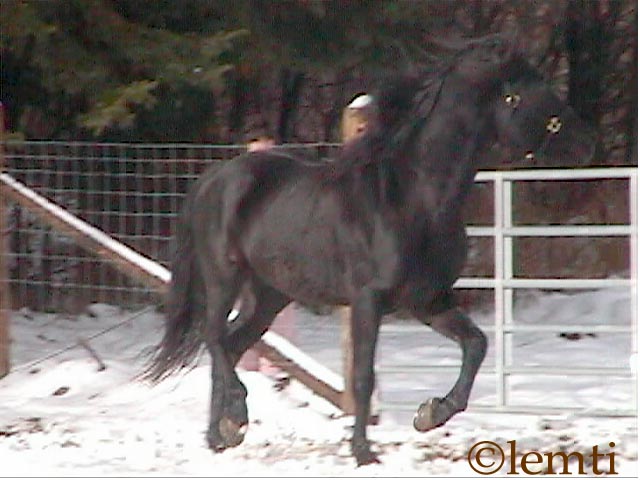CHEVAL CANADIEN ( CANADIAN HORSE )
DRAFT OF NEW ARTICLE ON THE CHEVAL CANADIEN HORSE
Nicknamed the "Little Iron Horse", the Canadian horse has worked it's way into our hearts, bringing children to school, food to farmers families, and wood in to heat their homes on cold winter nights. Still used today, this versatile breed is noted for it's endurance and strength, but also for it's hardiness and versatility (did well in international driving competitions, dressage, hunter, jumper, eventing, western disciplines and endurance). The rough terrain of New France had removed any animals which could not stand up to the rigors of the new world. Wintered on straw, the Canadian had to adapt to a cold climate while working and clearing the land with little to eat as farmers had little to feed themselves let alone their livestock. These horses became smaller in size, but developed a sturdiness found in no other breed. The Canadien is a result of natural selection and breeding to fit the uniquely Canadian climate. The first horse to gallop on Canadian soil was unloaded in Quebec on June 25, 1647. The original horse stock were Andalusians, Arabs, Bretons and Anglo-Norman horses brought to Quebec from France.
Generally, the Canadian Horse is black, but colors also range from bay to light chestnut. A stallion can weigh 1050-1350 lbs. and the mare 1000-1250 lbs. They are 14.2 to 16.1 hands in height. The Canadien has a well proportioned body with an especially well muscled legs. The mane and tail are thick, long and wavy. The Canadien is generally very easy to handle. The Canadian is a late bloomer but he also lives longer and is still useful at an advanced age. The mares are extremely fertile and reproduce regularly until the age of 25.
When the British overtook Quebec, they found the robust Canadian horse an ideal candidate to crossbreed their horses of various lineages to, leaving a trail of half breeds. The Civil war and Boer war also took a toll on the Canadian as animals were used as cavalry mounts, hauling artillery on the battlefield, but legend has it not once did the Cheval Canadien (Canadian Horse) shirk his duty. Thousands of these animals died leaving only a few to carry on the proud name the Cheval Canadien / Canadian Horse so rightly deserved.
Today, breeders across Canada are working hard to save this breed for future generations to enjoy while maintaining a part of Canadian heritage which so few know about. The populations of Cheval Canadien horses are wide spread throughout Canada but most horses are in Quebec and Ontario. Mares tend to be highly fertile as a result of natural selection in the Cheval Canadien horse and natural mating has produced a large number of foals. So the breed is spreading well. Canada's own unique breed The Cheval Canadiens / Canadian Horses were much loved and utilized by the early settlers because of their strength, willingness, and small food requirements. Their numbers rose quickly so that by 1850 there were approximately 150,000 Canadiens. However the importing of other breeds and exporting to the United States for use in various wars meant the horse was in danger of disappearing as a distinct breed. The number of Canadien Horses had declined to under 400 in1976. As early as 1886 efforts had been made to increase the numbers of the Canadien breed. Efforts have continued throughout this century with the result that there are presently over 4000 Cheval Canadien / Canadian Horses
PERCHERON
Breed Characteristics
The Percheron is usually gray or black. The gaits are supple and light; the head is fine with a square, wide forehead, long, thin ears, a lively eye, straight nose and wide nostrils; the neck is long with an abundant mane and the throat is thin. The withers are well set; the shoulder is well slanted; the chest is wide and deep with a somewhat prominent breast bone; the back is short and straight and very strong; the ribs are rounded; the girth is low with full flanks; the hip is long as is the croup; and the tail is set high. The limbs are sound and clean, well set with a powerful forearm and wide and muscular thighs. The buttocks are low; the knees wide and straight in line with the shoulder. The cannon bones are wide, flat and strong; the pasterns are clean and strong and the feet are good. The average height is between 14.3 to 16.1 hands.
|
 |